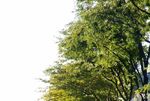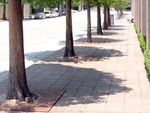22 Benefits of Urban Street Trees
←
→
Page content transcription
If your browser does not render page correctly, please read the page content below
22 Benefits of Urban Street Trees
By Dan Burden, Senior Urban Designer
Glatting Jackson and Walkable Communities, Inc; May, 2006
U.S Forest Service facts and figures and new traffic
safety studies detail many urban street tree benefits.
Once seen as highly problematic for many reasons,
street trees are proving to be a great value to people
living, working, shopping, sharing, walking and
motoring in and through urban places.
For a planting cost of $250-600 (includes first 3 years
of maintenance) a single street tree returns over
$90,000 of direct benefits (not including aesthetic,
social and natural) in the lifetime of the tree. Street
trees (generally planted from 4 feet to 8 feet from
curbs) provide many benefits to those streets they
occupy. These trees provide so many benefits that
they should always be considered as an urban area
default street making feature. With new attentions
being paid to global warming causes and impacts
more is becoming known about the many negative
environmental impacts of treeless urban streets. We
are well on the way to recognizing the need for urban
street trees to be the default design, rather than a
luxury item to be tolerated by traffic engineering and
budget conscious city administrators.
The many identified problems of street trees are
overcome with care by designers. Generally street
trees are placed each 15-30 feet. These trees are
carefully positioned to allow adequate sight triangles
at intersections and driveways, to not block
illumination of the street from overhead lamps, and
not impact lines above or below ground. Street trees
of various varieties can be used in all climates,
including semi-arid and even arid conditions.
The science of street tree placement and maintenance
is well known and observed in a growing number of
communities (i.e. Chicago, Illinois; Sacramento,
Davis, California; Eugene, Oregon; Seattle, Redmond,
Olympia and Issaquah, Washington; Charlotte, N.C.).
Although care and maintenance of trees in urban
places is a costly task, the value in returned benefits is
so great that a sustainable community cannot be
imagined without these important green features.
1Properly placed and spaced urban street trees
provide these benefits:
Increased motorized traffic and pedestrian safety
(contrary to popular myths). See below article for
details on mode safety enhancements. See
especially the compilation of safety benefits
detailed in, Safe Streets, Livable Streets, by Eric
Dumbaugh Journal of the American Planning
Association, Vol. 71, No. 3, Summer 2005. One
such indication of increased safety with urban
street trees is quoted from this document:
“Indeed, there is a growing body of evidence suggesting that the
inclusion of trees and other streetscape features in the roadside
environment may actually reduce crashes and injuries on urban
roadways. Naderi (2003) examined the safety impacts of
aesthetic streetscape enhancements placed along the roadside and
medians of five arterial roadways in downtown Toronto. Using a
quasi-experimental design, the author found that the inclusion of
features such as trees and concrete planters along the roadside
resulted in statistically significant reductions in the number of
mid-block crashes along all five roadways, with the number of
crashes decreasing from between 5 and 20% as a result of the
streetscape improvements. While the cause for these reductions is
not clear, the author suggests that the presence of a well defined
roadside edge may be leading drivers to exercise greater caution.”
1. Reduced and more appropriate urban
traffic speeds. Urban street trees create
vertical walls framing streets, and a
defined edge, helping motorists guide
their movement and assess their speed
(leading to overall speed reductions).
Street safety comparisons show a
reduction of run-off-the-road crashes and
overall crash severity when street tree
sections are compared with equivalent
treeless streets. (Texas A and M
conducted simulation research which
found people slow down while driving
through a treed scape. These observations
are also noted in the real world when
following motorists along first a treed
portion of a street, and then a non treed
portion. Speed differentials of 3 mph to
15 mph are noted.
22. Create safer walking environments, by
forming and framing visual walls and
providing distinct edges to sidewalks so that
motorists better distinguish between their
environment and one shared with people. If
a motorist were to significantly err in their
urban driving task, street trees can deflect or
fully stop a motorist from taking another
human life.
3. Trees call for planting strips, which
further separate motorists from pedestrians,
buildings and other urban fabric.
4. Increased security. Trees create more
pleasant walking environments, bringing
about increased walking, talking, pride, care
of place, association and therefore actual
ownership and surveillance of homes,
blocks, neighborhoods plazas, businesses
and other civic spaces.
5. Improved business. Businesses on
treescaped streets show 20% higher income
streams, which is often the essential
competitive edge needed for main street
store success, versus competition from
plaza discount store prices.
6. Less drainage infrastructure. Trees
absorb the first 30% of most precipitation
through their leaf system, allowing
evaporation back into the atmosphere. This
moisture never hits the ground. Another
percentage (up to 30%) of precipitation is
absorbed back into the ground and taken in
and held onto by the root structure, then
absorbed and then transpired back to the
air. Some of this water also naturally
percolates into the ground water and
aquifer. Storm water runoff and flooding
potential to urban properties is therefore
reduced.
37. Rain, sun, heat and skin protection.
For light or moderate rains, pedestrians
find less need for rain protection. In cities
with good tree coverage there is less need
for chemical sun blocking agents.
Temperature differentials of 5-15 degrees
are felt when walking under tree canopied
streets.
8. Reduced harm from tailpipe
emissions. Automobile and truck exhaust
is a major public health concern and
contains significant pollutants, including
carbon monoxide (CO), volatile organic
compounds (VOC), nitrogen oxides
(NOx), and particulate matter (PM).
Tailpipe emissions are adding to asthma,
ozone and other health impacts. Impacts
are reduced significantly from proximity
to trees.
9. Gas transformation efficiency. Trees in
street proximity absorb 9 times more
pollutants than more distant trees,
converting harmful gasses back into
oxygen and other useful and natural
gasses.
10. Lower urban air temperatures. Asphalt
and concrete streets and parking lots are
known to increase urban temperatures 3-7
degrees. These temperature increases
significantly impact energy costs to
homeowners and consumers. A properly
shaded neighborhood, mostly from urban
street trees, can reduce energy bills for a
household from 15-35%.
11. Lower Ozone. Increases in urban street
temperatures that hover directly above
asphalt where tailpipe emissions occur
dramatically increase creation of harmful
ozone and other gasses into more noxious
substances impacting health of people,
animals and surrounding agricultural
lands.
412. Convert streets, parking and walls into
more aesthetically pleasing environments.
There are few streetmaking elements that do
as much to soften wide, grey visual wastelands
created by wide streets, parking lots and
massive, but sometimes necessary blank walls
than trees.
13. Soften and screen necessary street features
such as utility poles, light poles and other
needed street furniture. Trees are highly
effective at screening those other vertical
features to roadways that are needed for many
safety and functional reasons.
14. Reduced blood pressure, improved overall
emotional and psychological health.
People are impacted by ugly or attractive
environments where they spend time.
Kathlene Wolf, Social Science Ph.D.
University of Washington gave a presentation
that said “the risk of treed streets was
questionable compared to other types of
accidents along with the increased benefit of
trees on human behavior, health, pavement
longevity, etc.” She noted that trees have a
calming and healing effect on ADHD adults
and teens.
15. Time in travel perception. Other research
and observations confirm that motorists
perceive the time it takes to get through treed
versus non-treed environments has a
significant differential. A treeless environment
trip is perceived to be longer than one that is
treed (Walter Kulash, P.E.; speech circa 1994,
Glatting Jackson).
16. Reduced road rage. Although this may at
first seem a stretch, there is strong,
compelling research that motorist road rage is
less in green urban versus stark suburban
areas. Trees and aesthetics, which are known
to reduce blood pressure, may handle some of
this calming effect.
517. Improved operations potential. When
properly positioned and maintained, the
backdrop of street trees allow those features
that should be dominant to be better seen, such
as vital traffic regulatory signs. The absence of a
well developed Greenscape allows the sickly
grey mass of strip to dominate the visual world.
At the same time, poorly placed signs, signals,
or poorly maintained trees reduces this positive
gain, and thus proper placement and
maintenance must be rigidly adhered to.
18. Added value to adjacent homes, businesses
and tax base. Realtor based estimates of street
tree versus non street tree comparable streets
relate a $15-25,000 increase in home or
business value. This often adds to the base tax
base and operations budgets of a city allowing
for added street maintenance. Future economic
analysis may determine that this is a break-even
for city maintenance budgets.
19. Provides a lawn for a splash and spray
zone, storage of snow, driveway elevation
transition and more. Tree lawns are an
essential part of the operational side of a street.
20. Filtering and screening agent. Softens and
screens utility poles, light poles, on-street and
off-street parking and other features creating
visual pollution to the street.
21. Longer pavement life. Studies conducted in a variety of California environments
show that the shade of urban street trees can add from 40-60% more life to costly
asphalt. This factor is based on reduced daily heating and cooling
(expansion/contraction) of asphalt. As peak oil pricing increases roadway overlays,
this will become a significant cost reduction to maintaining a more affordable
roadway system.
22. Connection to nature and the human senses. Urban street trees provide a
canopy, root structure and setting for important insect and bacterial life below the
surface; at grade for pets and romantic people to pause for what pets and romantic
people pause for; they act as essential lofty environments for song birds, seeds, nuts,
squirrels and other urban life. Indeed, street trees so well establish natural and
comfortable urban life it is unlikely we will ever see any advertisement for any
marketed urban product, including cars, to be featured without street trees making
the ultimate dominant, bold visual statement about place.
6You can also read

























































